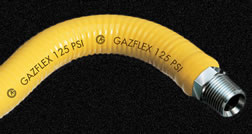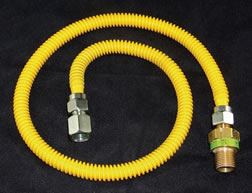Natural gas is odorless until we add mercaptan, an odorant similar to rotten eggs, to help detect leaks. If you smell natural gas or have a natural gas emergency, leave immediately and call us from another location.
Natural gas leaks: 800-261-5325
Safety tips
Natural gas is safe when properly used. Follow these tips to prevent accidents:
- Install and maintain at least one carbon monoxide detector on each floor of a home or business.
- Never use your oven or range for heating a home.
- See if gas range flames are crisp, quiet and blue. Yellow flames indicate need for adjustment.
- Clean range tops by washing burners with water and mild detergent.
- Keep an all-purpose fire extinguisher in a kitchen.
- Clean or replace air filters in heating systems at least annually.
- Keep chimney flues and appliance vents clean and in good repair.
- Have a qualified contractor inspect furnaces, vents, appliance connectors and chimneys for corrosion and blockages at least every other year.
- Keep areas around furnaces and water heaters clean and free of clutter and flammable liquids.
- Check water heater air intakes, drain pipes, controls and flue to ensure they are unobstructed.
- Set water heater temperature to 120 degrees F to prevent scalding.
- Never hang things from natural gas piping.
- Follow a space heater's instructions carefully and use with proper ventilation.
- Have corrugated stainless steel tubing inspected to make sure is properly bonded and grounded.
- Keep gas meters free of debris, snow, ice, vegetation and other obstructions.
- Call 811 or the local utility locating service at least three days before you plan to dig.
Appliance connections
Make sure your appliance connectors are safe. Older connectors made from brass may crack, break or deteriorate.
Even newer connectors made from stainless steel should be replaced every 10 years. Have a qualified HVAC or
plumbing professional inspect your gas appliances. Do not attempt to move or inspect natural gas appliances on your own.
More information on natural gas appliance connectors
Excess flow valves
An excess flow valve (EFV) is a safety device designed to automatically stop the flow of natural gas through
the service line if it exceeds a predetermined rate. When activated, an EFV may prevent the buildup of natural
gas and lessen the potential for property damage and/or injury. It should be noted that these devices generally
do not protect against slow leaks, such as those caused by corrosion or loose fittings, or leaks located along
customer-owned piping beyond the natural gas meter.
Many customers already have an EFV installed on their existing natural gas service line.
Customers who do not have an EFV may be eligible to have one installed at their own expense.
Cost typically ranges from $850 to $2,000 depending on the location and conditions of the installation site.
Customers can request more information about EFV installations by calling our 24-hour customer service at
800-242-9137.
Corrugated stainless steel tubing

Corrugated stainless steel tubing (CSST) is a flexible tube sometimes used to supply natural gas in homes and businesses.
Used since 1990, CSST may have been used for natural gas piping in your home if you added a new natural gas appliance such
as a stove or furnace. Danger: Improperly bonded and grounded CSST can result in natural gas leaks or fires in buildings
struck by lightning. Learn about our CSST policy requirements. CSST is often coated in yellow or black.

Do not confuse CSST with natural gas appliance flexible connectors. Flexible connectors typically attach directly to natural
gas appliances from a floor or wall appliance shut-off valve. CSST typically is routed beneath, through or along floor
joists in the basement, inside interior wall cavities and on top of ceiling joists in attic spaces. In Wisconsin, all CSST,
regardless of manufacturer exemptions, must be bonded and grounded. First generation CSST must be bonded to the structure’s
electrical system in accordance with NFPA 70 - National Electrical Code (NEC), and NFPA 54 - National Fuel Gas Code, using
bonding clamp(s) and wire sized appropriately per the manufacturer’s instructions. Inspect: If you have CSST installed at
your home or business, contact a licensed electrician to verify proper bonding. If not, the electrician can install proper
bonding. If you’re not sure if you have CSST, contact the company that installed the natural gas piping in your home or
business and ask for an inspection.
Natural gas distribution network
Natural gas distribution networks are subject to rigorous inspection, maintenance and oversight within our company
and by state and federal government. We maintain about 20,000 miles of natural gas distribution mains and 530 miles
of natural gas transmission pipelines throughout Wisconsin. We also maintain the pipes that connect the mains to
individual homes and businesses. Typically, we are responsible for the natural gas facilities up to the outlet of
your meter. Maintenance of additional buried natural gas pipes on your property is your responsibility. Examples
include pipes to mobile homes, detached garages, workshops, pools, spas and lighting. According to federal rules,
you are responsible to inspect buried piping on your property for leaks and corrosion. Any unsafe conditions must
be repaired or removed.
Our inspection and safety activities
- We survey for possible leaks on our distribution mains every year in populated communities and every other year in more rural areas. (Federal requirement for main surveys is once every five years).
- All transmission pipelines are surveyed for leaks at least once per year.
- All of our 1 million customer service lines are inspected within every three years. (Federal requirement for service line surveys is once every five years).
- We have corrosion protection on all steel pipe in our system. (Federal requirement requires corrosion inspections only on pipes installed prior to 1971.)
- Our corrosion protection is monitored continuously and tested every year.
- Wisconsin limits distribution system operating pressure at 60 psig (pounds per square inch). (Federal limit allows for distribution systems to operate at 125 psig.)
- Along with inspecting existing lines, we invest about $50 million every year in upgrading and replacing mains and service lines throughout the area.
- We work with local public safety agencies to provide emergency response training and safety information.
- Each year, we sponsor contractor workshops to reinforce safety guidelines for construction crews that work around natural gas and electric facilities.
For security reasons, we do not provide maps containing exact locations of pipelines. You can find pipelines in your community here:
National Pipeline Mapping System. Every other year, we send out a communication
to all customers within 1,000 feet of a transmission pipeline.
Pipeline safety
Most incidents involving natural gas pipelines involve a contractor or homeowner digging into buried distribution lines.
To avoid such situations, be sure to call 811, a national hotline for underground facility location and marking —
at least three days prior to digging. The free service uses flags and paint to mark underground utility facilities that
should be avoided when digging. When excavating around natural gas piping, dig by hand.